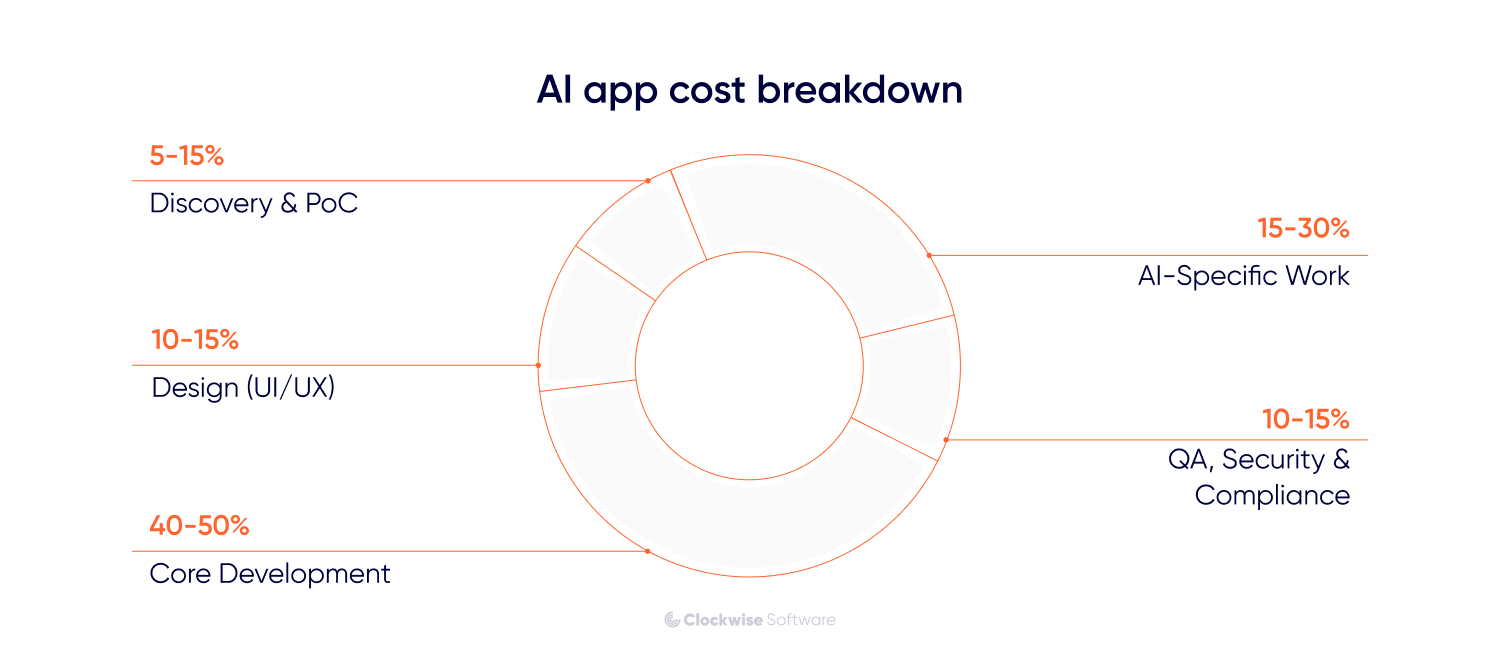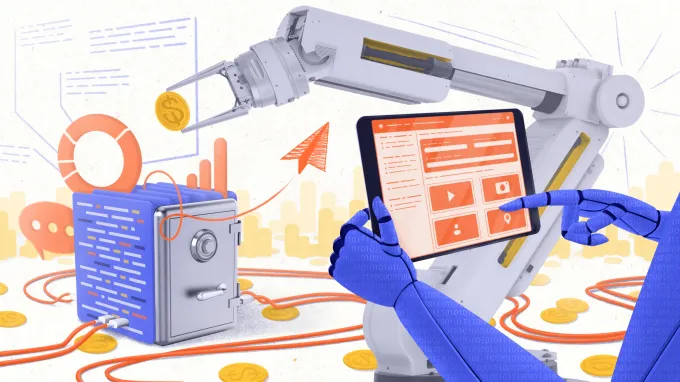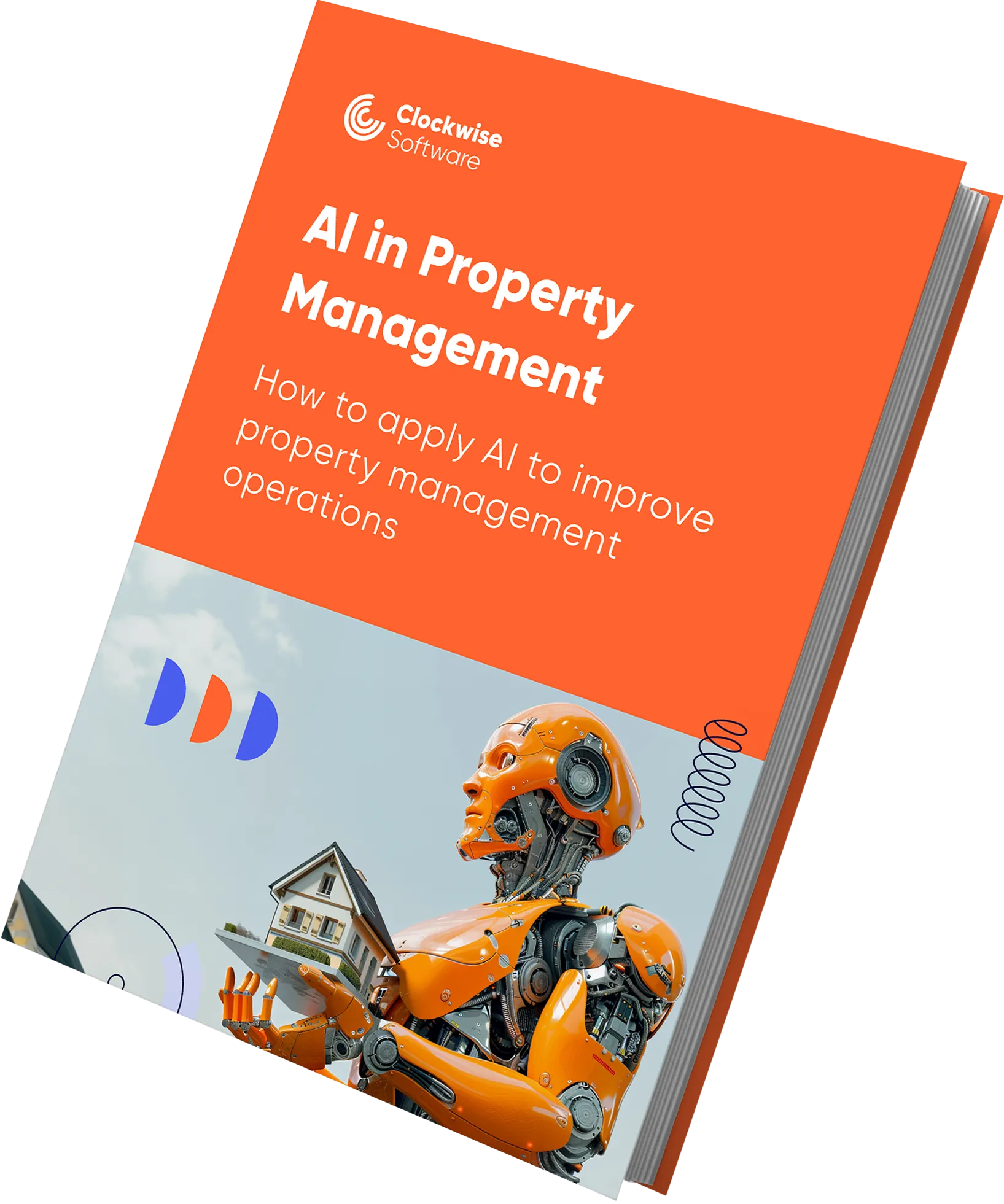AI App Development Cost in 2026: What you can build for $50K, $100K, and $250K
Key takeaways
- It’s not AI itself that pushes budgets up, it’s the overall feature complexity. A basic chatbot can be built quickly, but once you add dashboards, analytics, or multi-model workflows, the total development effort (and cost) grows fast.
- Data readiness can quietly stretch your budget. When information is scattered, unstructured, or inconsistent, cleaning and preparing it sometimes takes as much time as building the feature itself.
- Hidden costs often show up after launch. From cloud scaling to compliance and model retraining, some of the expensive challenges emerge once your AI app is live.
AI app development cost can look unpredictable at first glance. Some teams imagine sky-high numbers tied to massive data pipelines and custom models. Others hope they can ship a working product on a shoestring. The truth sits somewhere in between.
Our AI development company has delivered AI apps and integrations of very different sizes. We’ve worked on AI projects that cost $30K, and we’ve guided enterprise builds that required 300K+ to scale safely and reliably.
In this article, we’ll walk you through what actually shapes the cost of AI software development, what you can expect to get at different budget levels, and how to make smart choices that fit both your idea and your resources.
What “AI app development cost” actually means
When we talk about AI app development cost, we don’t mean building brand-new models from scratch; that’s work for research labs with million-dollar budgets. And let’s be honest, that’s probably not what you’re here for.
What we mean is far more practical: using proven prebuilt AI models via APIs and frameworks (like TensorFlow, PyTorch, or LangChain) to add value to your product, and fine-tuning them on your data for better accuracy. It could be a recommendation engine, predictive analytics, natural language processing, or smarter automation. The cost reflects the entire process of building an app with AI functionality, from discovery and planning to development, integration, and ongoing support.
With the definition clear, the next step is understanding what actually drives the AI app development cost estimate up or down.
Factors that influence AI app development cost
AI software price isn’t driven by development hours alone. AI-specific choices, such as model type and data quality, play a big role, but so do product design, tech stack, and infrastructure decisions.
App complexity
The more features you pack in, the higher the price tag of custom web app development. A single AI-powered add-on, like a chatbot or profile parse, can be done for a few thousand dollars. Add dashboards, analytics, payments, or CRM connections, and you’re looking at tens of thousands. Build out a full enterprise platform with multiple AI modules and strict compliance, and the budget quickly climbs past the $300K mark. Each extra piece means more coding, more testing, and more ongoing care.
AI capabilities
What your AI is supposed to do has the strongest pull on the budget. Lightweight features, like a website chatbot or an AI tool that parses resumes, can land in the $5K–$10K range. More data-heavy cases, such as building a predictive analytics engine, can stay around $30K–$40K if scoped well.
Advanced capabilities are a different story. Computer vision, speech recognition, or anomaly detection for IoT mean larger datasets, heavier infrastructure, and fine-tuning. Those projects almost always start at $100K+ and scale upward from there.
So, the ambition level of your AI is what decides whether you’re writing a check for tens of thousands or planning a six-figure investment.
AI model choice
Most products don’t need a brand-new model. Plugging into APIs from OpenAI, Google, or AWS lets you ship in weeks, often for $5K–$15K if the scope is narrow. The tradeoff is ongoing API bills and limited flexibility in how deep you can customize.
Going custom (whether that’s fine-tuning an existing model or training your own) flips the equation. You’ll spend more upfront (think $50K–$150K+ depending on the size of your dataset and compute needs) and wait longer, but you get tighter control over accuracy, behavior, and costs at scale. Read our AI frameworks comparison for more details.
It really comes down to priorities: do you need to move fast and validate an idea, or do you want long-term ownership and fine-grained control?
Data quality and availability
AI is only as good as the data behind it. If your datasets are already structured and consistent, adding AI can be fairly quick. But when information is scattered across spreadsheets, CRMs, or PDFs, a big chunk of the budget goes into getting it usable.
That might mean cleaning duplicates, labeling examples, or setting up pipelines so fresh data flows in automatically. In some cases, this prep work ends up costing as much as the feature itself. The same chatbot could double in cost if we first need to untangle years of messy records.
Platform and technology stack
The platform you choose shapes the budget as much as the AI itself. A simple web app is usually the most budget-friendly option, but if you also need to launch a mobile app with iOS and Android versions, expect the AI development cost to climb because every change has to be designed and tested twice. Cross-platform tools like React Native can cut that down, though they’re not always the best fit for heavy AI workloads.
And if your product needs to run on hardware (IoT devices, AR/VR headsets, or custom sensors), integration and testing can add another layer of expense. The tech stack you pick will set both the initial bill and the pace of your long-term maintenance costs.
Infrastructure and hosting
Even a simple chatbot needs cloud resources, though in that case, the monthly bill might stay modest. But as soon as you deal with heavier tasks, like real-time video analysis, you’re looking at dedicated GPU clusters that can cost thousands every month.
The choice of where to run it matters too, especially in AI-powered SaaS development. AWS, Azure, Google Cloud, or an on-prem setup each comes with different pricing models and support overhead. Get these choices wrong, and your app works fine, but your cloud bill hurts.
UX/UI design and user experience
The number and complexity of features directly affect design costs. More features mean more screens, states, and user flows to design, test, and refine. Once you add admin panels, reporting dashboards, or personalized experiences, design work quickly expands, and so does the budget.
Ongoing maintenance and support
An AI app is more of a living system than a one-time build. Models need to be refreshed, APIs get updated, accuracy has to be monitored, and infrastructure scales as usage grows. In practice, that means the first release is only the starting point. A good rule of thumb: set aside 15–20% of the initial budget each year for upkeep and improvements, whether you are working with in-house devs or a dedicated development team (DDT).
Knowing key AI app development cost factors is helpful, but it’s just as important to see where the money goes.
What’s behind your price
Understanding AI development cost drivers is one thing. But how does that translate into an actual project budget? Here’s how a typical AI app development cost breaks down in our projects:
- Discovery & PoC (5–15%). We start by running workshops, mapping out your processes, and shaping clear requirements. Often, we build a small proof of concept to test if the idea holds up before we commit to a full build.
- Design (10–15%). We focus on creating a consistent, intuitive user experience across the entire platform, making AI features feel like a seamless part of it. Sometimes that’s a simple chatbot window, other times it’s full dashboards, admin panels, and personalized feeds.
- Core development (40–50%). This is where most of the work happens: frontend, backend, and integrations that make the product usable beyond the AI.
- AI-specific work (15–30%). Here's the intelligence layer: data prep, plugging in APIs, fine-tuning or training models, and setting up pipelines and monitoring. In smaller apps, this part stays lean; in advanced products, it can take a bigger share.
- QA, security, compliance (10-15%). Our team validates the app end-to-end: functional testing, checking how the AI behaves on edge cases, and making sure data stays protected. In regulated industries, this slice grows.

With this AI app development cost estimate in mind, it’s easier to see where your project might land.
Cost ranges for AI app development
Here’s what AI app budgets usually look like. The numbers cover the whole build: not just the AI, but also frontend, backend, integrations, QA, and everything else that makes the product work. Costs go up as both the app itself and the level of AI get more advanced.
| Budget Range | What kind of AI app features | What you get | Good fit for |
| $50,000 – $80,000 | Basic AI add-on MVP | • Simple AI feature(s) like chatbot via existing API, basic recommendation logic, predictive dashboard
• Focused design with fewer screens or based on ready-made components • Essential backend and integrations • Smaller data prep scope |
Early-stage startups, SMBs wanting to test ideas, internal tools with one or two AI-powered functions |
| $80,000 – $120,000 | Growing product with multiple AI components | • 1-2 AI features (e.g. recommendation + NLP search)
• Expanded UI/UX and design scope • More integrations (payment, analytics, can include custom API work) • Scalable backend built to handle more users and data • Streamlined data prep / some model fine-tuning |
Startups with some traction, SMBs scaling operations, products with growing user base |
| $120,000 – $250,000+ | Advanced product with custom AI integration | • Multiple fine-tuned or customized AI models (LLMs, computer vision, etc.) working within your product architecture
• Larger UI/UX scope with custom design elements • Robust backend & infrastructure (scaling, performance, security) • Significant data engineering & model training efforts • Extra compliance/security features if needed |
Mature startups, product companies looking to gain competitive edge, businesses for whom AI is core value |
Costs rise when scope drifts
We can run a discovery phase to outline your AI product scope and provide clear, reliable estimates before development begins
What AI app you can get with different budgets
The scope of what you can build depends on your budget. Here’s what different investment levels typically cover when developing an AI-powered product from the ground up.
What you can get for $50K–$80K
This AI app development cost range usually covers a minimum viable product (MVP), an app with just enough features to launch, test your idea, attract early users, or automate a focused process. Most of the budget goes into a frontend and backend, essential integrations (payments, maps, analytics), and a lightweight AI feature powered by existing prebuilt models.
Instead of extensively training custom models, we connect proven ones via APIs like OpenAI and tailor them with custom prompts or your own content (articles, materials, or FAQs), so the AI does exactly what your business needs. That’s how we built the AI assistant on our website: it answers visitor questions in real time and reduces support load, all within MVP budget.
Other features in this budget range could be an FAQ chatbot for an online store, a simple recommendation engine, or a tool that scans customer reviews and tags the sentiment automatically.
You’re not paying for model training. The spend covers integration work, API usage fees, infrastructure, and light model customization, which is why a full MVP with AI can be built for as little as $50K and rarely exceeds $80K unless non-AI complexity is added.
Read also: Cost of developing custom web applications
What you can get for $80K–$120K
This budget lets you expand your product with more features, deeper AI integration, and stronger infrastructure. Here, the setup stays strong (separate backend and frontend, clean database, scalable cloud), but the scope gets bigger. You can add more AI features, user roles, and richer design without cutting corners.
You can combine models (for example, retrieval-augmented search plus a chatbot), and fine-tuning on your own data becomes realistic. AI shifts from a supporting role to driving everyday use. A good example among our projects is Releasd’s PR platform, where we created a tool for automated analysis of PR campaigns, pairing GPT-4 with Gemini: one looks at sentiment and key messages, the other pulls out mentions and quotes. Together, they cut down the manual grind of PR analysis and show everything in clear dashboards.
Other features in this budget range could include:
-
an e-commerce experience with recommendations plus semantic product search
-
a healthcare tool that pairs a triage chatbot with risk predictions
-
a media platform that classifies content and personalizes feeds
-
a logistics app that combines route optimization with demand forecasting
AI development cost increases with scope: each new feature, integration, or dataset adds more work to build and support. Expect some data prep, evaluation/monitoring, and orchestration across AI models. That extra depth is why projects in this bracket usually land between $80K and $120K.
What you can get for $120K–$250K+
Here, AI stops being a feature and becomes the backbone of how the app works. These solutions are designed to scale, serve bigger user bases, and run several AI components together.
This is where things get serious. You're no longer just calling a single AI API, you’re orchestrating several models, fine-tuned or custom-trained, that work together through APIs and data pipelines. At this level, you can:
-
Fine-tune large language models on your own data.
-
Train computer vision systems to spot defects, recognize products, or analyze scans.
-
Combine text, images, and even audio for multimodal features.
-
Roll out predictive analytics that forecast revenue, demand, or fraud risk.
In practice, products in this budget range can look like this, depending on the industry:
-
Healthcare: a telemedicine app that reads scans with vision models and drafts doctor notes with an LLM.
-
E-commerce: visual search tied to recommendation engines that personalize every shopper’s feed.
-
MarTech: content-generation and campaign-optimization models that personalize messaging for each audience segment and surface insights for marketers.
-
Real estate: valuation engines trained on market data alongside rental demand prediction.
AI app development cost rises because the setup gets more complex: models are customized further, connected across features, and built to handle more data and users. Add in compliance for industries like healthcare or fintech, and it’s clear why this level of build usually lands between $120K and $250K+. You can read more about AI features for real estate for more information.
From $50K MVPs to $250K+ enterprise builds, we’ve done it all
Let’s find where your idea fits and how to make it scale
We've looked at what you should get for your investment. Next, let’s cover the costs that can quietly sneak in.
Hidden costs you should be aware of
Even with a solid AI app development cost estimate, some expenses appear later in the process. They’re not always part of the initial AI app development scope, but can have a noticeable impact on the total budget. Being upfront about these helps you plan more realistically.
Infrastructure scaling
Cloud costs are usually estimated at a baseline. But if your user base grows faster than expected, or your AI models require GPU-heavy environments for training and inference, monthly bills can increase significantly.
API usage fees
When using third-party AI providers (e.g., OpenAI, Google Cloud, AWS), initial costs look low. But as usage scales (thousands of queries per day, high-volume fine-tuning, or premium API tiers), AI app development cost rises beyond the early budget.
Model retraining
AI performance degrades over time if models aren’t updated (“model drift”). Retraining on new data or fine-tuning after launch requires additional time, infrastructure, and sometimes external expertise.
Compliance and legal audits
If your product grows into regulated markets (healthcare, fintech, HR), you may face unexpected costs for HIPAA, GDPR, or SOC2 compliance, from legal consultations to extra development for data protection.
Third-party integrations
Every third-party integration, like a CRM, ERP, or payment system, requires extra development work and testing, and that affects the budget. Integrating new services means extra development hours not included in the initial scope.
Monitoring and support
AI apps need more than bug fixes. You may need logging, monitoring dashboards, and alerting systems to track model accuracy and app stability. We usually include monitoring tools in the scope to track performance and stability after launch.

Conclusion
So, how much does AI software cost? There isn’t a single AI app development cost breakdown. The range runs from about $50K for a basic app to $250K+ for enterprise products that use heavily customized or fine-tuned AI models.
The good news: you don’t have to take unnecessary risks or overspend. Start small, prove the idea, then scale with the right stack and integrations. That way, every dollar goes toward the right functionality and moves your product forward.
We’ve shipped 200+ projects since 2014, including AI builds. We’ve seen where budgets leak and where they pay off. If you’re planning an AI app, we’ll help you size it honestly and build it in a way that makes sense for your business.
You don’t need a massive budget to launch an AI feature
We’ll help you build a solution that fits your use case perfectly, while staying cost-efficient
FAQ

Any questions unanswered?
Let's discuss them

